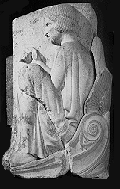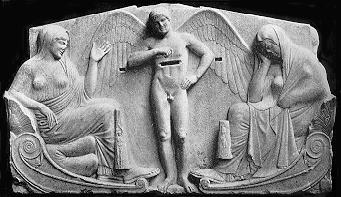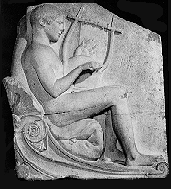| "The Boston Throne seems to have been produced a little after the Ludovisi Throne because of its complimentary composition." R. Carpenter, 1929. |
 |
 |
 |
| An old woman is sitting on the ground with her knees drawn up. She has the short hair of slavery or mourning. She is holding something which has been chiselled away. (She has been reconstructed as a spinner.) Below her, in the bottom corner, is a fish. The whole panel is badly damaged, and severely cut away. | A naked winged youth is smiling as he holds scales (now lost) which would have been inserted into the front of the throne. The scales' lower parts are carved in marble as solid wedge like blocks, each with a figure of a naked youth in a very low relief standing with his arms above his head, feet barely touching the pan. The right youth is in full view, the left in profile. (Unfortunately, no close up images were available to illustrate this.) On either side is a woman. The woman on the winged youth's right is smiling at the sinking scale, and lifting her open left hand. She is wearing an Ionian tunic with a mantle. Below her, in the bottom corner, is a fish. The woman on his left is similarly dressed, but more completely wrapped in her mantle which hangs down and hides the cushion she is sitting on. She holds her head on her right hand in a gesture of despondency towards the rising scale. Below her, in the bottom corner, is a pomegranate. Both lean on the palmettes and volutes on the bottom of the throne. They are more integrated with this framing device than the figures on the Ludovisi Throne. |
|
| It is critically agreed that the Boston Throne is of much lower quality than the Ludovisi. It is weaker in its total effect because of its characterisation, e.g. the nude is less round and has none of the linear beauty of the nude on the Ludovisi. The treatment of drapery, the soft smirking youth, the general rendering of the figures and the use of inserts for effect set it appart from the Ludovisi Throne and contemporary Greek art. When compared it seems doubtful that they were completed by the same hand. Whilst the Ludovisi Throne seems to fit naturally into 5th Century B.C. practice, the Boston Throne does not. Due to further problems concerning its discovery, and its meaning, the function and origin of the throne have been variously interpretated by different critics. |